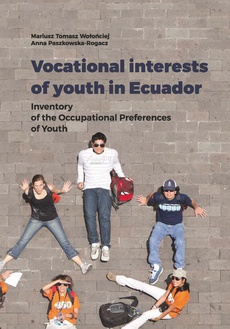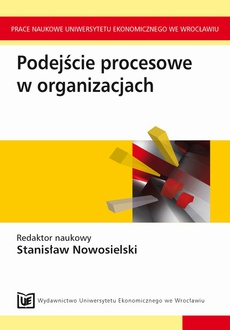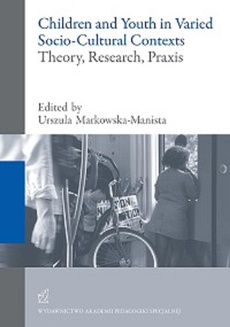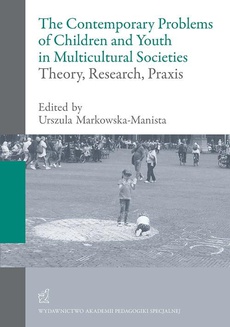POLECAMY
Vocational interests of youth in Ecuador
Inventory of the Occupational Preferences of Youth
Wydawca:
Format:
ibuk
This methodologically sound psychometric tool has been handed to Ecuadorian psychologists and teachers as a guide in the career counselling field. The tool will have a significant impact on the democratization of youth, assisting them to make well-targeted choices when planning their education and career.
The authors’ study may be viewed as pioneering work, due to its consideration of the significant cultural and geographic regional differentiation among graduates from the Pacific coast, the Andes, the Amazon rainforest and the Galapagos Islands.
Reaching to the classics of literature on the subject (primarily Holland, Super, Prediger and Strong), the authors have performed a momentous work, which is the construction of a psychometric tool that will be helpful in diagnosing career interests in the entire population of Ecuadorian youth.
Worth additional acknowledgement are the high reliability indicators of the career interests questionnaire conducted on a representative and large study group, as well as the defined psychometric accuracy of the scale.
This publication makes a civilizational quantum leap in the education of Ecuadorian youth, guaranteeing them a career choice that corresponds to their interests and ambitions. This pioneering publication on the Polish and world markets confirms the fact that Polish psychologists have the capability to „export” the psychometric school of thought to the Latin American region, with all of the scientific, social and humanitarian consequences involved.
| Rok wydania | 2018 |
|---|---|
| Liczba stron | 176 |
| Kategoria | Publikacje darmowe |
| Wydawca | Wydawnictwo Uniwersytetu Łódzkiego |
| ISBN-13 | 978-83-8088-864-7 |
| Numer wydania | 1 |
| Język publikacji | angielski |
| Informacja o sprzedawcy | ePWN sp. z o.o. |
Ciekawe propozycje
Spis treści
| Introduction | 7 |
| 1. The context of occupational guidance in Ecuador | 11 |
| 1.1. New challenges of the labor market in Ecuador | 13 |
| 1.2. Cultural diversity as a challenge for vocational guidance in Ecuador | 19 |
| 1.3. Ecuadorian youth in the school to work transition | 23 |
| 1.4. Youth passivity and work instability in the labor market | 24 |
| 1.5. Need for tools in occupational guidance in Ecuador | 26 |
| 1.6. Legal aspects of professional guidance in Ecuador | 27 |
| 2. Determinants and correlates of career choice | 31 |
| 2.1. Physical constitution and health in professional choices | 33 |
| 2.2. How does temperament influence occupational choices? | 35 |
| 2.3. Ability as an occupational success predictor | 37 |
| 2.4. Interests as personality traits | 42 |
| 2.5. Beliefs and values as vocational preferences predictors | 44 |
| 2.6. Personality and vocation | 48 |
| 2.7. Stages of career development | 53 |
| 2.8. Career decisions of youth | 57 |
| 3. Theoretical background of the IPPJ questionnaire | 61 |
| 3.1. The theory of John Holland | 61 |
| 3.2. Beyond the RIASEC code letters: Diagnostic aspects of the profile | 65 |
| 3.2.1. Congruence of professional interests | 66 |
| 3.2.2. Consistency of professional interests | 67 |
| 3.2.3. Differentiation of vocational interests | 70 |
| 3.2.4. Identity and vocational interest | 72 |
| 3.3. Prediger’s Model of work environment classification | 73 |
| 3.4. Typology of jobs according to Holland and Prediger | 75 |
| 4. The design of the questionnaire | 79 |
| 4.1. The construction of the pilot version | 80 |
| 4.1.1. The pilot study | 81 |
| 4.1.2. The validity study | 85 |
| 4.1.3. The validity study of the 60 item version | 92 |
| 4.1.4. Confirmatory Factor Analysis | 99 |
| 4.1.5. The reliability of the IPPJ scale | 101 |
| 4.1.6. Internal reliability scale: Duplicated items in “Lay key” | 105 |
| 4.1.7. Reliability as test-retest stability of the IPPJ scores | 107 |
| 4.1.8. Construct validity study through the analysis of intergroup differences | 111 |
| 4.1.9. Degree of diversity and intensity of interest | 116 |
| 5. Normalization procedure and analysis | 119 |
| 6. Scales’ scores calculation | 123 |
| 7. In the search of new techniques for vocational guidance practice | 125 |
| Conclusions | 129 |
| Bibliography | 131 |
| Appendices | 141 |
| Appendix 1. The pilot version of the IPPJ (120 items) | 143 |
| Appendix 2. Answer sheet for the pilot version IPPJ (120 items) | 149 |
| Appendix 3. The key of the pilot version scales (120 items) | 151 |
| Appendix 4. Items of the final version (60) with type codes after Factor Analysis of the pilot version (120) | 152 |
| Appendix 5. The final version of the INVENTARIO DE PREFERENCIAS PROFESIONALES DE JÓVENES (IPPJ) (60 items) | 155 |
| Appendix 6. The key of the IPPJ (final version) | 159 |
| Appendix 7. The translation of the IPPJ items from Spanish into English | 160 |
| Appendix 8. Sten norms for vocational interests of girls (N = 962) (R, S, E, C scales) | 163 |
| Appendix 9. Sten norms (R, S, E, C) for professional interests of boys (N = 970) | 164 |
| Appendix 10. Sten norms (I, E) for professional interests for girls and boys (N = 1932) | 165 |
| Appendix 11. Sten norms for Holland’s Differentiation indicators | 166 |
| Appendix 12. Sten norms for Iachan’s Differentiation indicators | 167 |
| Appendix 13. Sten norms for the Intensity Indicators | 168 |
| Appendix 14: The answer sheet: the table profile or/and the hexagon profile | 169 |
| List of figures | 171 |
| List of tables | 173 |

























